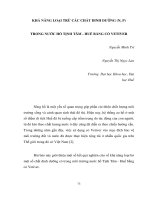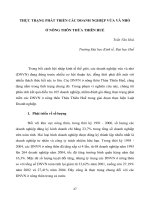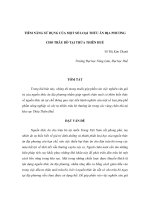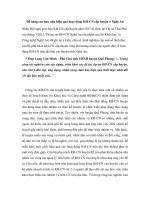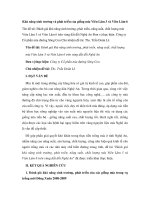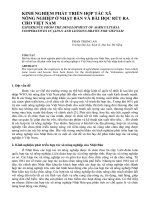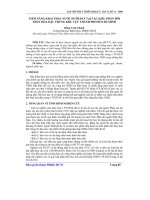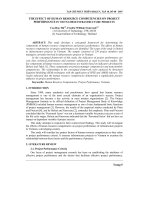Báo cáo nghiên cứu khoa học: "Tiềm năng phát triển trong hệ thống quản lý, vận hành và bảo trì các hệ thống mặt đất làng cung cấp nước trong lưu vực sông Huai sam mor, tỉnh Khon Kaen" pptx
Bạn đang xem bản rút gọn của tài liệu. Xem và tải ngay bản đầy đủ của tài liệu tại đây (6.31 MB, 13 trang )
245
JOURNAL OF SCIENCE, Hue University, N
0
61, 2010
POTENTIAL DEVELOPMENT IN SYSTEM MANAGEMENT, OPERATION
AND MAINTENANCE OF VILLAGE GROUND WATER SUPPLY SYSTEM
IN HUAI SAM MOR WATERSHED, KHON KAEN PROVINCE
Chatchawal Kiratiworasakun, Warangkana Sunsitthisawad
Faculty of Public Health, KhonKaen University
Kiksanachai Ruangjab
Water Resources Regional Office 4, Khon Kaen
SUMMARY
In the Huai Sam Mor Watershed, Khon Kaen Province, there are 15 village ground
water supply systems. Recently, only 8 of these systems have kept operating at Sub Somboon
Sub-district, Khoke Pho Chai District, Khon Kaen Province. This survey of village ground water
supply found that the administrative committees and the system operator had never been trained
in water supply management. There was also a lack of system maintenance, lack of daily system
monitoring, no washing of the filter and tower tank as a designated program, a lack of adjusting
the water pressure, and no chlorination before distribution. The major activities of this research
required by the village water supply management committees are to develop the potential
capacity on water supply management by practical training. Being practically trained would
provide knowledge about operation and maintenance of ground water supply management to
the village water supply management committees. After two months of the development training,
an improvement in the water supply system was reported as indicated by cleanliness of the
water supply system area, water pump checking, adjusting the water pressure according to the
tower tanks’ height, and cleaning filter tanks. However, schedules for regular and continuous
performance still relies on the village water supply management committee’s awareness to
maintain good water quality within the water supply system.
Keywords: potential development, village ground water supply system, village water
supply management committee.
1. Introduction
In Huai Sam Mor Watershed, Khon Kaen Province, there are 15 village ground
water supply systems. 13 of them are located in Khoke Pho Chai District, and other two
systems are in Manchakiri District. In Khoke Pho Chai District, there are two village
ground water supply systems in Pho Chai Sub-district and 11 in Sub Somboon Sub-
district. However the village ground water supply systems have encountered the
problem of raw water shortage. Currently, only eight systems are in operation, which
246
are in Sub Somboon Sub-district, which was the focus for this study.
Five village ground water supply systems were constructed based on the design
of the Groundwater division, Department of Mineral Resources (Former), and Ministry
of Industry. Three systems were constructed based on the design of the Water Supply
Division, Public Works Department (Former), and Ministry of the Interior. Afterwards,
they are to been turned over to be under the responsibility of the village water supply
management committees. The Sub Somboon Sub-district Administrative Organization
has been providing the academic knowledge for system operation and maintenance.
There have been several problems regarding the ground water supply
management of these eight ground water supply systems. The reason seemed to be the
turn over of the village administrative committees, village headman, and maintenance
personnel. Especially, most of the operators had never undergone training on how to
operate and maintain the ground water supply system. Lack of maintenance has caused
a shortening of the life span of the groundwater supply system. It was found the
operator did not clean the filter as well as the tower tanks as per the cleaning schedule.
Also, there was neither daily monitoring nor adjusting of water pressure. Besides, the
electricity for water pumping and chlorine use are high. When the electricity cost could
not be reduced, chlorine usage is then reduced instead. As a result, the biological
quality of the treated ground water could not pass the standard of drinking ground water
(Ministry of Industry, 2542). Moreover, there is a drought problem during the dry
season. The amount of ground water being pumped is low, which caused low water
pressure in the water pipes. The water demand is getting higher, but the water supply is
not adequate. In addition, the ground water containing limestone or high hardness
causes a blockage in the water pipes. Water supply distribution in some areas has to be
rearranged by setting a schedule time, which causes inconvenience to the water users.
The village ground water supply system, Sub Somboon Sub-district, Khoke Pho
Chai District, Khon Kaen Province, had been faced with the problem of water supply
management (Somkid Singsong, 2552). In order to improve the village water supply
system to produce clean tap- water safe for consumption, requires an efficient system of
management. The research for the potential development is necessary in order to find a
way to improve the village groundwater supply system management including operation
and maintenance systems. All of which are the fundamental public utilities that are
required for improving quality of life.
Objectives
This research aims to study the operation and maintenance of village ground
water supply systems which are operated by the village water supply management
committee, and to study the means of potential development of system management,
operation and maintenance
247
Scope of Research
1. Conduct the potential development of village groundwater supply system by
discussing the requirements of the village water supply management committees in all
eight places. This is to improve the operation and maintenance system according to the
designed schedule that would further improve the water quality to a certain level.
2. Study the village water supply system focusing on the ground water supply
system, which was turned over from the Department of Mineral Resources, Ministry of
Industry, and the Regional Water Work, Public Works Department, Ministry of Interior;
to Sub Somboon Sub-district Administrative Organization, Khoke Pho Chai District,
Khon Kaen Province.
3. Data collection was divided into 2 phases: 1) before taking actions, and 2) 2
months after solving the problems of water supply system
4. Use the study of Tap Water Quality and Satisfaction of Water Users of
Village Ground Water Supply in Huai Sam Mor Basin, Khon Kaen Province
(Warangkana, Chatchawal, and Kiksanachai, 2552) to detect whether any water quality
parameters of the referred study were below the Standard of Drinking Water Quality of
Deep Wells (Ministry of Industry, 2542), water samples were collected and analysed for
such water quality parameters after 2 months implementation of the development
process.
2. Methodology
2.1.The research pattern is Action Research
2.2.The study population was divided into 3 groups as follows
2.1.1. Eight village ground water supply systems, in Huai Sam Mor Watershed,
Khoke Pho Chai District, Khon Kaen Province, which have been turned over to the
village water supply management committees and Sub-district Administrative
Organizations, located in 7 villages: Nhong Ya Plong, Sub Dang, Sub Bon, Non Sawang,
Sub Somboon, and Sub Charearn, as shown in Table 1 and Figure 1.
2.1.2. The village water supply management committees, as the village
representatives who manage the village water supply system. The total is 28 peoples
consisting of chairman, secretary, treasurer, and other members.
2.1.3. The water supply operators were the representatives of the villages,
whose job description is managing, operating, monitoring, and maintaining the water
supply system to provide consistency in water supply production.
2.3. The research tools were divided into 3 parts as follows:
2.3.1. A checklist was used for surveying the environmental condition and
completeness of the structure of water supply system as well as the actual performance
248
of the operator.
2.3.2. A questionnaire for interviewing the village water supply management
committees consisted of 2 parts. 1) General data of the village water supply
management committees including the duration of holding the post, how to achieve the
current post holding, other duties in the village, and training to manage the village
water supply system, etc. 2) The performance status in human resources, finance,
materials, and management.
2.3.3. A questionnaire for interviewing the village water supply operators
comprising of 3 parts. 1) General data about the operator including duration of the
holding the post, how they came to hold the current post, other duties in the village, and
the training to manage the village water supply system, etc. 2) Operational data of
building systems according to the maintenance schedule, which is modified from the
operation assessment according to the maintenance schedule of Water Resource
Department (2549). 3) An open-end questionnaire for the maintenance problems in
water supply system.
2.4. Procedure
2.4.1. The purpose of the research (November, 2551) was stated during a
monthly meeting for the Sub Somboon Sub-district Administrative Organization and
cooperation in the research from the community leader, the water supply management
committees was requested.
2.4.2. The problems in the operation of village water supply systems from the
operators point of view were studied by using checklists and direct interviews.
2.4.3. The problems in management were studied by interviewing the village
water supply management committees about the management and operation process.
2.4.4. The groundwater quality criteria of the project entitled “ Tap Water
Quality and Satisfaction of Water Users to village Ground Water Supply in Huai
Sam Mor Basin, Khon Kaen Province (Warangkana, Chatchawal, and Kiksanachai,
2552) was used as the fundamental water quality data of this research for determining a
potential development process
2.4.5. A focus group was performed in order to ascertain the means of potential
development.
2.4.6. Assignments for village water supply systems such as; problem
assessments, missed- performance of the operator, management of the village water
supply management committees, and water quality problems were designated. A part of
the water quality problems might be from the mal-function of the water treatment
process and periodic maintenance, e.g., backwash of sand filters and the cleanliness
around the water supply system areas.
249
2.4.7. Informed, followed up, and evaluated the assignment and responsibilities.
The assignment evaluation was made by interviewing the operator group, and village
water supply management committees based on the structured questionnaire.
Examination of water quality for the problematic parameters relevant to the water
supply process as well as operational obstacles were undertaken by collecting the data
after 2 months of group meetings, which were in February, 2552.
2.4.8. Water quality between before and after the potential development process
was compared. Water quality was improved after implementation of potential
development process, e.g. iron and coliform bacteria.
2.5. Data analysis was performed by using descriptive statistics such as
percentages, averages, and standard deviations. Knowledge in water supply systems
were analysed using T-Tests to test the difference between averages before and after the
training.
3. Results
3.1. Village ground water supply systems before the implementation of
potential development
3.1.1. Maintenance status
The village water supply system operated by the village water supply
management committees, under the responsibility of Sub Somboon Sub-district
Administrative Organization, Khoke Pho Chai District, is the small scale of deep water
supply, which has an angle-corner-shape of equal-side pentagon. This design is
according to the former pattern of the Department of Mineral Resources (former),
Ministry of Industry, and Water Supply Division, Public Works Department (former),
Ministry of the Interior. The village water supply system started with pumping
groundwater from a deep well to the aeration unit, where dissolved iron and manganese
are precipitated. Then the water is pumped to be stored in the tower storage tank of 12
cubic meters in capacity. The water is distributed using the pressure from the tower
storage tank through iron and manganese filter tank, without chlorine addition, into the
distribution line to the consumers via water meter.
Before implementation of potential development, the condition of the village
groundwater supply system of 8 places was noted as follows. There was no sign
indicating animal raising was prohibited in the area. Almost all water supply systems
distribute water for a whole day except one place distributes water only morning to
evening due to insufficient water. Half of the water supply systems (4 places) had not
been cleaned around the area of deep well, tower tank, filter tank, and were covered
with overgrown grass and garbage. All deep wells were equipped with PVC pipes. Two
deep wells ‘PVC pipes were covered with weeds and garbage. All water supply systems
250
have water pumps, which were in good shape and maintenance. However, the operator
did not perform the following aspects; adjusting the pumping control system, cleaning
the tower tank and filter tank, and adding chlorine before distributing water to the
consumers ( Tables 4 and 5).
3.1.2. System management
System administration of the village water supply is under the responsibility of
the village headman. This research studied 7 villages and 8 groundwater supply systems.
One village has landscape laid along side the Highway 229, which divides into 2 water
distribution and water supply systems.
From interviews with 35 village water supply management committees in 7
villages showed that males were 85.7% with average age at 47. 80 + 8.62 years old (the
oldest was 66 years old, and the youngest was 30 years old); 57.1% of them had
primary school education, 91.4% of them were married, 5.7% widows, 91.4% were
farmers who grew sugarcane, 5.7% were businessmen, and 2.9% were workers.
Regarding the post holding for village water supply management committees, the
average post holding time was 3.76 + 3.66 years (the longest as 20 years, and the
shortest as 3 months). the village water supply management committees was voted by
54.3% of the villagers, 22.3% of the village leaders. 20.0% of their titles (headman),
2.9% of Sub-district administrative Organization. The proportion of the village water
supply management committees included 20.0% as the president, 8.6% as vice president,
8.6% as treasurer, 42.8% as members of the committees, and 20.0% as water supply
operators.
3.1.3. Management of village groundwater supply activities
There was one group of village water supply management committees per one
village. There were 8 water supplies in 7 villages. Hence, there were total of 7 groups of
village water supply management committees. The village headman held the position as
president of the village water supply management committees.
The organization structure of the village water supply management committees
were different in number of members; 5 people (3 villages), 7 people (2 villages), and 3
people (2 villages). The main positions of the organizational structure was one president,
one treasurer, one maintenance person. The rest were members of the committee. All of
the village water supply management committees had not ever undergone the training
for managing the village water supply system.
There were 7 operators who participated in the study. The average age was
52.28+10.29 (The oldest was 66 years old and the youngest was 30 years old). Four of
them had primary school education; two had finished high school and one had a
diploma. All of them were married. The main occupation were farmers with 5 persons,
251
the others were one worker and one businessman. They were working as water supply
operator for an average of 5.86+6.59 years (20 years was the longest, and 1 year was the
shortest.). They became the village water supply operator from the selection by
villagers (4 persons), by the head of village, (2 persons) and by Sub-district
Administrative Organization (1 person). None of them had ever undergone the training
for water supply system operation and maintenance.
The criteria of selection of the village water supply system operator varied
among villages. The criteria were set by the study team in questionnaire. The
interviewee could give more than one answer. 5 villages selected the persons who could
do accounting; 4 villages chose the person who knew about electricity, and 2 villages
did not identify any criteria. Regarding the compensation, 4 villages did not get any
compensation, while 3 villages received compensation of 250 baht; 1,000 baht, and
2,000 baht. The persons who are responsible for recording water use unit data were the
operator (2 villages), committee (2 villages), treasurer (2 villages), and headman (1
village). The person whose jobs are collection of water utility bills were the committee
members (3 villages), treasurer (2 villages), operator (1 village), and headman (1
village). The person who managed the accounting were the treasurer (4 villages ); the
headmen (2 villages); and the committee (1 village ).
3.1.4. Finance
Four villages did not have financial support for the operation while 3 villages
received financial support for the operation of 10,000-12,000 baht from Sub-Somboon
Sub-district Administrative Organization. The main income of 6 villages was from the
water utility bills. the other was from the water utility bills and financial support from
Sub Somboon Sub-district Administrative Organization.
In all water supply units, the consumers pay bill based on the amount of used
water meter. The price per a water meter was different among villages 5 baht (4
villages); 4 Baht (2 villages) and 3 baht (1 village). The bill paid was declared by the
receipt of the water supply unit. The revenue of 30,000-40,000 Baht per year received
from the water utility bills. While the expenditure was about 20,000-30,000 baht per
year. The revenue allocation was by only one person who were either a committee
member (5 villages) or the president (2 villages). The allowance for reserve money in
cash was over 1,000 baht (4 villages) and under 1,000 baht (3 villages). The income
was deposited in the bank for 5 villages. The saving was around 10,000-40,000 baht.
The saving amount was deposited in the bank monthly (2 villages) or by the
convenience for 3 villages. However, the last 2 villages did not have enough income for
the bank.
3.1.5. Equipment management
There was an allowance for fix-up and maintenance of the water system in 4
252
villages. The other 3 villages did not have any allowance. There were spare equipments
in storage in 5 villages. They were easily damaged. Other 2 villages did not keep any
spare equipments. When the equipment was damaged, the operator was ready to fix the
problem (3 villages). The problem had to be inspected before fixing (2 villages). The
problem had to be endorsed from the village water supply management committees
before proceeding (2 villages).
3.1.6 . Water supply management
The water supply units distributed the water to the consumers all day. There was
only one village that distributed water in the morning and in the evening. Most of them
did not write down the procedures of management (5 villages). Two villages had written
management procedures. The village water supply management committees had clearly
identified their responsibilities. Six villages had group meetings. One village did not
have any meetings or identify their responsibilities. The frequency of the meeting was
about 2-4 times a year. Four villages wrote the minutes of the meeting every time. Most
of them, 5 villages, had the list of the members. Two villages did not have the
membership list. Five villages had savings accounts. Two villages did not have savings
accounts because they did not deposit the money at the bank. Almost all villages, 6
villages had the accounting for the water supply units correctly and completely. Only
one village did not have accounting for the water supply unit.
Most villages, 4 villages broadcasted the information about the water supply and
monthly income. While 3 villages did not inform or broadcasted such information. The
operation data for water production, expense and financial records were audited in 4
villages. For 3 villages, they had never inspected or followed up the operation.
3.1.7. Quality of tap water
The data of tap water quality before the potential development project was
drawn from the study of Warangkana, et al 2552 as mentioned previously. It was found
that the sample of tap water from all the distribution sources did not meet the standard
of drinking deep well water. For all water supply units, the water quality problem was
due to chemical and toxic substances. For biological criteria, 2 water supply units did
not meet the standard. All water supply units met the physical standard. The water
quality parameters exceeding the standard were Cadmium, Iron, Permanent Hardness,
Total Dissolved Solids (TDS), Nitrate, and Total Coliform Bacteria
There were 16 water quality parameters studied in this research, including color,
turbidity, pH, Fe, Mn, Cu, Zn, Cl, No
3-
, Total Hardness as CaCO3, Permanent Hardness,
TDS, Cd , Total Bacteria were determined by the Standard Plate Count, Multiple
Tube Technique (MPN) for Coliform and E.coli. It was found that the tap water sample
collected from the distribution of Ban Sub Somboon # 1, Ban Nonsawang and Ban Sub
Somboon #2 and Ban Nachan. Distribution met the Water Quality Standard of Drinking
253
Water of Deep Well as 93.75%, 87.50%, 75% of total studied water quality parameters,
respectively.
3.2. Potential development in system management, water supply operation
and maintenance of village groundwater supply system
The potential development in system management, water supply operation and
maintenance of village groundwater supply system was carried out by the team of
people who are involved in water supply management, operation and maintenance. This
was to determine the problems and solutions, assign the responsibilities, plan for
implementation, and coordinate all the related works. The meeting place and training
were at the meeting room in Sub Somboon Sub-district Administrative Organization,
Khoke Pho Chai District, Khon Kaen Province. The participants and trainer were total
of 35 people. The meeting was on December, 2551. The details are as follows.
3.2.1. The results from the workshops revealed that water supply system
operators and committees. were lacking knowledge for how to produce good water
quality. The water treatment operating process has been done by old methods. They had
not ever been trained on this water treatment operation and maintenance. They wanted
to have knowledge and skills to improve water supply management. Therefore, the
researchers setup the training sessions in operation and maintenance of groundwater
supply system.
3.2.2. The training sessions were set up for the village water supply management
committees, water treatment operator and maintenance, and the consumer
representatives. The topic of the training course was entitled “Management, operation
and maintenance of village groundwater supply system”. The course provide
knowlegde of the water supply management process. The training course showed the
results of data collected from the first phase of study including accounting, income,
expenses, accounting audit, status of the current water supply system/water treatment
operation and maintenance, as well as the structure of the standard water supply system.
3.2.3. The trainee/participants were divided into 7 groups. The problems
identified in each village were assessed from 3 groups; the village water supply
management committees, operator, and consumers. The trainers were invited from the
Water Management Section 4, Water Resource Regional Office 4, Khon Kaen, and the
researchers, Khon Kaen University. The training course included theory and practice
organized at the learning center in village groundwater supply unit Moo 10, Ban Sub
Charearn, where the system structure is the pattern of Department of Mineral Resources
(former), Ministry of the Industry.
3.2.4. Pre-tests and post-tests were conducted to know the trainee/ participants’
general knowledge of water supply production, operation and maintenance. The
maximum score was 25 for 25 questions. A total 35 people participated in the test.
254
Before the training course, the average score was 6.76 + 3.97. After the training course,
the average score was 16.03 + 4.49. The score was 9.27 higher in average. The average
score after the course was significantly higher than the one before the course in terms of
statistics (p-value < 0.05) (as shown in Table 2). Before the workshop, the question that
most trainees answered correctly question no.12 that is the main pipes should be laid out
deep under the ground according to the designed plan. The second was question no.2,
that was water in the orchard canal and vegetable patch were not the surface water
source and they could not be used to produce tap water. In term of question no.20, that
is sand filter should be cleaned every 2 days or 24 hours of the operation or when
blockage was found. The questions were answered correctly at 74.29%, 54.29%, and
48.57%, respectively. The question that the trainees answered incorrectly the most was
no.10 to check the residual chlorine in the village water supply system, the water from
the ending tap of the main water distribution. For question no.21, the residual chlorine
was checked when chlorine had contact with the water for at least 30 minutes and this
should be done at the end of the pipe. And question no.19, when the water pump was
not functioning as normal, the yellow light at the front of the water pump control panel
would be on. The questions were answered correctly 5.74%, 5.74%, and 8.57%,
respectively. The question that all the trainees could not answered was 1 phase electric
power between 220-240 volts (as shown in Table 3).
After the workshop, the question that the trainees all answered correctly was no.
13, that PVC pipes used as water supply pipes should be blue. Next was question No. 17
is that the good quality of the water supply operator was diligent, eager to learn the
work, patient, sacrifice, and honest. This question was answered correctly 85.71%.
Question No.24 that was water meter showing the figures can be read as 20 cubic
meters. And question no.25 is that water supply operator would be handing over the job
description when deceased, resigned, or when the water supply management committees
or Sub-district Administrative Organization agreed to dismiss the current operator and
question No 2. All three of them were equally answered correctly 82.86%. The question
that the trainees answered incorrectly the most was also no. 21. The next was no. 22
that 3 phase electric power were between 340-420 volts. And no.5, the sand filter in
the village water supply system should be 0.45-0.55 millimeters. They were answered
correctly 22.86%, 28.57 % and 37.14 %, respectively (as shown in Table 3).
3.2.5. The researchers inspected each water supply systems one month after
finishing the training course. They had evaluated the water supply operation 2 months
after the workshop had ended. It was revealed that the status of eight village ground
water supply systems (as shown in Table 4 and Table 5) and the overall water supply
area (7 places) were cleaner. All water supply systems had water pumps, water gates,
functioning equipment, and a maintenance schedule. For the maintenance process, the
maintenance operator in all area followed the instruction after the training course. They
255
checked the water pumps, adjusted the raw water pressure according to the height of the
high water tank, cleaned the rust filter tank (cleaned the sand filter). The sand filter was
be cleaned weekly in 2 places and monthly in 6 places. But the sludge was not drained
out. The high water tank would be cleaned. This was because the work required many
people (villagers but at that time the villagers were hired for rice and sugarcane
harvesting. All the maintenance operators had to wait for more people to be available,
which expected to be in March, 2552. The task that the maintenance operator could not
do were the cleaning of the groundwater well and draining the sludge in the main water
distribution pipes. This was because the tasks are costly and a lack of equipments.
Therefore, they were waiting for the support from the other related divisions. They did
not do chlorination before distribution because the consumers and the village water
supply management committees did not realize the importance and chlorine was smelly.
For the water quality evaluation, the water samples were collected from the
distribution units. The water quality, in terms of chemical and the contaminants were
tested repeatedly during February, 2552. It was found that the water in Ban Sub
Charearn had iron content met the standard. for Cadmium, permanent hardness, total
dissolved solids, and nitrate contents in water samples collected from all places did not
meet the standard. The water quality needed to be improved in order to reduce the
contamination. For the biological water quality, it was found that the water sample
collected from Ban Sub Dang and Ban Nachan had high bacteria content. It did not
meet the Standard of drinking Water for deep wells (Ministry of the Industry, 2542).
4. Conclusion
The Potential Development in System management, Operation and Maintenance
of Village Groundwater Supply Systems in Huai Sam Mor Watershed, Sub Somboon
Sub-district, Khoke Pho Chai District, Khon Kaen Province, seemed to be a moderate
success. The main activity required for developing the potential that the village water
supply management committeeswas the workshop which would help them improve the
system management, and operating and maintaining the system correctly. The good
practice for consistency and continuity of good water quality production depended on
the personal responsibility and the awareness of the village water supply management
committees.
Acknowledgement
The researchers would like to thank the Integrated Water Resource Management
Research and Development Center in Northeast Thailand, Faculty of Agriculture, Khon
Kaen University (IWRM-KKU) for the funding support for the research. Thankfulness
is given to the lecturers from Water Management Section 4, Water Resource Regional
Office 4, Khon Kaen Province for participating in the workshop and sharing the
knowledge with the village water supply management committees, supply controllers,
256
and consumers. The workshop was about, “Management, operation and maintenance
of village groundwater supply system”. Lastly, the researchers would like to thank the
Environmental Health Science Department, Faculty of Public Health, Khon Kaen
University, for supporting the equipment, tools, and facilities for the research.
REFERENCES
1. Ministry of Industry, 2542. The standard criteria for edible ground water.
Announcement no. 12 (2542) issued in Ground Water Act, 2520. Principle and standard
in theory for preventing public health and the environment from poisoning. Published
in the government gazette, book 112, chapter 29, April 13, 2542.
2. Warangkana Sunsitthisawad, Chatchawal kiratiworasakun, Kiksanachai Ruangjab, 2552.
Tap water. Quality and Satisfaction of Water Users to village Ground Water
Supply in Huai Sam Mor.
3. Basin, Khon Kaen Province, KKU Research Magazine, 14(10): Page 961-975. Somkid
Singsong, 2552. Study of Huai Sam Mor Watershed: First 3 years as pioneer (2549-
2551). Team members of Huai Sam Mor Watershed in Shi River Watershed, Khon
Kaen Province: Page 5-10.
4. Thai Industrial Standards Institute, 2549. Drinking Water Industrial Standards. TIS. 257.
2549. Ministry of Industry. Published in the government gazette, announcement and
general work edition. Volume 123. Chapter 64. July 6, 2549.
257
Illustrator 1. The location of the ground water supply systems in Huai Sam Mor Watershed,
Khoke Pho Chai District, Khon Kaen Province.

